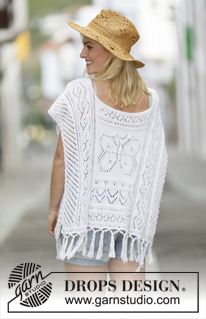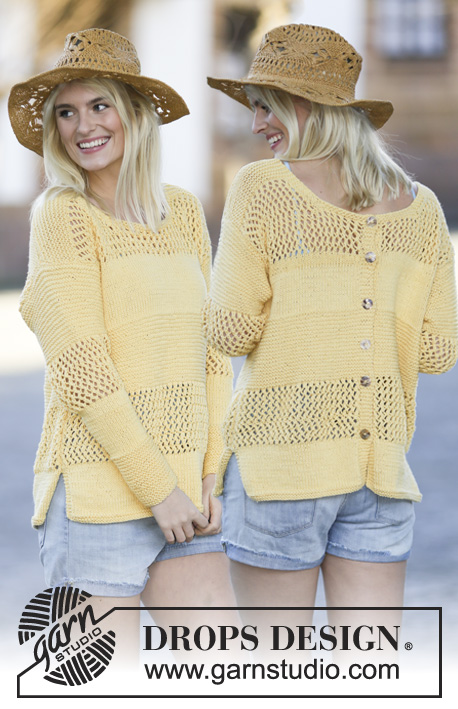Comments / Questions (117)
![]() Elke wrote:
Elke wrote:
Hi, ich bin gerade angefangen zu stricken. Reihe 1 soll die Hinreihe sein. Und in jeder 6. Reihe (immer Hinreihe!) sollen amRand die Löcher gestrickt werden. Aber wenn Reihe 1 eine Hinreihe ist, kann Reihe 6 keine Hinreihe sein. Soll ich nach! 6 Reihen, also in Reihe 7 die Löcher arbeiten am Rand? Vielen Dank für eine Antwort. Gruß Elke
11.07.2024 - 20:52DROPS Design answered:
Liebe Elke, Sie zählen nach der 1. Reihe die 6. Reihe ab. Es ist also nicht Reihe 6 ab dem Anschlag, sondern nach der 1. Reihe werden 5 Reihen ohne Löcher am Rand gestrickt (= Rück-R, Hin-R, Rück-R, Hin-R, Rück-R), in der 6. Reihe (= Hin-R) werden dann die Löcher gestrickt. So setzen Sie es dann fort. Viel Spaß beim Stricken!
12.07.2024 - 10:07
![]() Kim Dwyer wrote:
Kim Dwyer wrote:
Hi, is this pattern available with written instructions? I am unable to follow chart patterns. Thank you.
11.02.2023 - 06:24DROPS Design answered:
Dear Kim, the pattern is only available as posted online, with both written instructions and charts. You can check out the following lesson for help reading knitting charts: https://www.garnstudio.com/lesson.php?id=68&cid=19. Happy knitting!
13.02.2023 - 00:04
![]() Anna Auriemma wrote:
Anna Auriemma wrote:
Buongiorno, volevo sapere se il diagramma A4 è stato aggiornato (la farfalla) se si dove lo trovo grazie
25.01.2023 - 20:56DROPS Design answered:
Buonasera Anna, la farfalla è il diagramma A.9 ed è già stato aggiornato: quello sul sito è corretto. Buon lavoro!
25.01.2023 - 21:40
![]() Sharon wrote:
Sharon wrote:
I am unable to use circular needles I have to knit with long pins - could I split this into back & front and if so how many extra stitches would I need to allow for seams? I love all your patterns, and am an experienced knitter. Just struggling to ‘go for it’ and purchase pattern and yarn….
24.07.2021 - 10:31DROPS Design answered:
Dear Sharon, we have a lesson on how to adapt a pattern for straight needles HERE. I hope it will help. Happy Stitching!
24.07.2021 - 12:15
![]() Marilyn wrote:
Marilyn wrote:
Hallo, Ik zou graag dit patroon willen bestellen hoe doe ik dit,nog nooit gedaan ben dr helemaal weg van Ik hoor graag van u Vriendelijke groet Marilyn
19.07.2020 - 11:59DROPS Design answered:
Dag Marilyn,
Je kunt het patroon gratis afdrukken door op de knop 'Afdrukken' onder de materialenlijst bij het patroon, te klikken. Vervolgens klik je op 'patroon' en dan in het venster dat dan in beeld komt, klik je helemaal rechts boven op 'Het patroon afdrukken' om hem naar je printer te sturen.
20.07.2020 - 08:35
![]() Vivi Lejsgaard wrote:
Vivi Lejsgaard wrote:
Hej igen:-) Diagram A1 = højde 14 , A2 og A3 højde på 12. Diagram A4 og A5 en højde på 16, hvordan passer det sammen? Hvis jeg strikker A5 + A6 + A7 (1 1/2 gang) hvad sker der så, når jeg når 8 rækker op, hvor der ikke kan opdeles i et halvt mønster? På forhånd tak:-) Mvh. Vivi
02.07.2020 - 14:37DROPS Design answered:
Hei Vivi. Du strikker halve mønster i bredden, ikke i høyden. Så når du strikker A.7 (mellom merkene), strikkes diagrammene A.2, A.4, A5 og A.3 som før. Les gjerne vår steg-for-steg leksjon på "Hvordan lese strikkediagram", som du finner nederst på oppskriften. God Fornøyelse!
06.07.2020 - 09:54
![]() Vivi Lejsgaard wrote:
Vivi Lejsgaard wrote:
Jeg har brug for hjælp, for når der er 41 masker tilbage, kan jeg ikke lave diagram 7A til 7C, hvor der er 31 masker.
29.06.2020 - 20:25DROPS Design answered:
Hej Vivi, jo du strikker A.7A (5masker), A.7B 1½gang (30 masker), A.7C (6masker) ialt 41 masker. God fornøjelse!
02.07.2020 - 11:02
![]() SIVIGNON wrote:
SIVIGNON wrote:
Bonjour, concernant le tricot de A6, au début, il est dit que pout toutes les tailles, il faut continuer ainsi, c'est à dire qu'on tricote le 3eme rang de A6 en entier A6A+A6B+A6C jusqu'à la fin de la grille càd 8 rangs? Merci de votre réponse. Valérie.
12.03.2020 - 12:01DROPS Design answered:
Bonjour Mme Siviginon, je ne comprends pas votre question avec le 3ème rang de A.6. Vous devez tricotez les 8 rangs de A.6 ainsi: 4 m de bordure, continuez A.2 et A.4 comme avant, tricotez ensuite A.6 entre les marqueurs (= 1 x A.6A, répétez A.6B et terminez par 1 xA.6C), continuez A.5 et A.3 comme avant et terminez par 4 m de bordure. Au 3ème rang de A.6, tricotez la dernière m de A.6A avec les 2 premières m de A.6B, puis la dernière m de A.6B avec les 2 premières m du A.6B suivant/de A.6C (= le 1er jeté = dernière m du diagramme). Bon tricot!
12.03.2020 - 13:03
![]() Mimi wrote:
Mimi wrote:
Bij de Nederlandse vertaling staat bij Rand st: ... brei elke 5e nld... Bij alle andere vertalingen wordt er de 6e nld genoemd. Wat is nu juist?
17.02.2020 - 11:42DROPS Design answered:
Dag Mimi,
Het moet inderdaad iedere 6e naald zijn. Waarschijnlijk is er een foutje in de Nederlandse vertaling geslopen. Bedankt voor het doorgeven; het is nu aangepast. Veel breiplezier!
20.02.2020 - 21:27Liely Aritanty wrote:
May I download free patten?
16.05.2018 - 04:00DROPS Design answered:
Dear Mrs Aritanty, our pattern can only be printed but you can use a virtual printer to save them as a .PDF file. Happy knitting!
16.05.2018 - 09:54
Riviera Maya#rivieramayaponcho |
||||||||||||||||||||||||||||
 |
 |
|||||||||||||||||||||||||||
Knitted DROPS poncho with lace pattern and fringes in ”Cotton Light” or "Belle". Size: S - XXXL.
DROPS 159-1 |
||||||||||||||||||||||||||||
|
GARTER ST (back and forth): K all rows. 1 ridge = 2 rows K. PATTERN: See diagrams A.1 to A.9. The diagrams show all rows in pattern seen from RS. EDGE STS: Work the outermost 4 sts in each side in garter st but on every 6th row (always from RS) work holes as follows: At beg of row: K 2 tog, 1 YO, K 2 tog, 1 YO. At end of row: 1 YO, K 2 tog, 1 YO, K 2 tog. ---------------------------------------------------------- PONCHO: Worked in 2 parts that are sewn tog on the shoulders. FRONT PIECE: The piece is worked back and forth on circular needle because of no of sts. Cast on 139-147-155 sts on circular needle size 3 mm with Cotton Light or Belle. Work first row as follows from RS: 4 EDGE STS - see explanation above, work pattern according to diagram A.1 until 5 sts remain on row, work 1st st in A.1 and finish with 4 EDGE STS. Continue the pattern like this - NOTE: On 7th row in A.1 K last st before edge sts. When A.1 has been worked, switch to circular needle size 3.5 mm. Insert 1 marker after the first 47-51-55 sts on needle and 1 marker after the next 45 sts (= 47-51-55 sts after last marker at the end of row). ALL SIZES: Work next row as follows from RS: 4 edge sts as before, work A.2 over the next 12-16-20 sts, work A.4 (= 31 sts), 1st marker, A.6A (= 4 sts), work pattern according to diagram A.6B until 5 sts remain before 2nd marker, A.6C (= 5 sts), A.5 (= 31 sts), work A.3 over the next 12-16-20 sts and finish with 4 edge sts as before. Continue pattern like this. There will be lanes with lace pattern upwards on each side of markers and work borders with lace pattern between the 2 markers. REMEMBER THE KNITTING TENSION. Size S/M and L/XL: Continue to ALL SIZES. Size XXL/XXXL: When A.6 has been worked one time vertically, work 3 ridges between markers (work the other sts as before), then work A.6 one more time between markers (continue the other sts as before). ALL SIZES: When A.6 has been worked, work pattern according to diagram A.1 between the 2 markers mid front (continue the other sts as before) AT THE SAME TIME on next to last row in diagram (= RS) dec 4 sts evenly (= 41 sts between markers and 135-143-151 sts on row). After A.1 work A.7 between the 2 markers as follows (continue the other sts as before): Work A.7A (= 5 sts), work A.7B until 6 sts remain before marker and finish with A.7C (= 6 sts). When A.7 has been worked, work pattern according to diagram A.8 between the 2 markers (continue the other sts as before). AT THE SAME TIME on last row in diagram (= RS), inc 3 sts evenly (= 44 sts between markers and 138-146-154 sts in total on needle). After A.8 work pattern according to diagram A.9 between the 2 markers. When entire A.9 has been worked (piece measures approx. 39-39-43 cm), there are 45 sts between markers. Then work pattern according to diagram A.1 between markers (continue the other sts as before). After A.1 work A.6 between markers as follows: A.6A (= 4 sts), work A.6B until 5 sts remain before marker and finish with A.6C (= 5 sts). SIZE S/M: Continue to ALL SIZES. SIZE L/XL + XXL/XXXL: When A.6 has been worked one time vertically, work 3 ridges between markers (work the other sts as before), then work A.6 one more time between markers (continue the other sts as before). ALL SIZES: After A.6 work 3 ridges between markers (work the other sts as before), then cast off the 45 sts between markers for neck and finish each part separately. Continue pattern back and forth as before over the 47-51-55 sts on shoulder - NOTE: Continue the outermost 2 sts towards the neck in garter st. When 4 cm remain before piece measures 60-64-68 cm (adjust so that next row is worked from RS), switch to circular needle size 3 mm. Continue with pattern according to diagram A.1 before loosely casting off. Repeat in the other side. BACK PIECE: Cast on and work as front piece. ASSEMBLY: Sew the shoulder seams. The poncho should be open in each side. FRINGES: Fasten fringes along the bottom edge of poncho both front and back. Fasten fringes in holes in A.1. 1 fringe = cut 6 lengths of 35 cm each. Fold them double, pull the loops true the holes and pull the yarn ends true the loops. Fasten each fringe approx. 3 cm apart. Then split the fringes in 2 and tie tog with next fringe. Continue like this with all fringes. |
||||||||||||||||||||||||||||
Diagram explanations |
||||||||||||||||||||||||||||
|
||||||||||||||||||||||||||||

|
||||||||||||||||||||||||||||

|
||||||||||||||||||||||||||||

|
||||||||||||||||||||||||||||

|
||||||||||||||||||||||||||||

|
||||||||||||||||||||||||||||
Have you finished this pattern?Tag your pictures with #dropspattern #rivieramayaponcho or submit them to the #dropsfan gallery. Do you need help with this pattern?You'll find 22 tutorial videos, a Comments/Questions area and more by visiting the pattern on garnstudio.com. © 1982-2025 DROPS Design A/S. We reserve all rights. This document, including all its sub-sections, has copyrights. Read more about what you can do with our patterns at the bottom of each pattern on our site. |
||||||||||||||||||||||||||||





































































Post a comment to pattern DROPS 159-1
We would love to hear what you have to say about this pattern!
If you want to leave a question, please make sure you select the correct category in the form below, to speed up the answering process. Required fields are marked *.